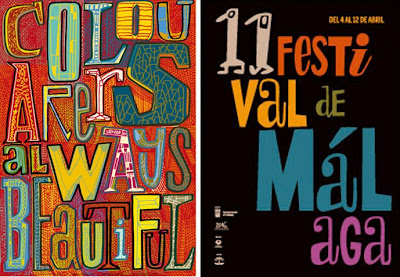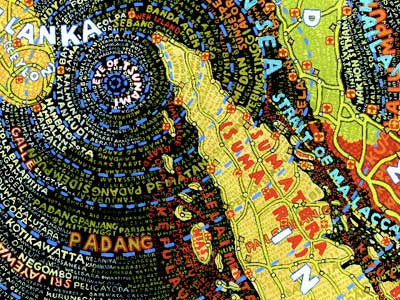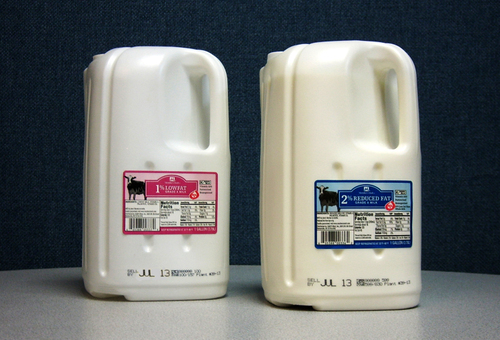Wednesday 31 March 2010
Coverline Brand Identity Development and Design
Posted by
Katarzyna Matuszewska
08:44
TASK 6: Packaging Design Unwrapped
Posted by
Katarzyna Matuszewska
06:10
Role of Packaging
Packaging is the science, art and technology of protecting products for distribution, storage, sale, and use. Packaging also refers to the process of design, evaluation, and production of packages.
Packaging design has traditionally been viewed as a means of protecting the contents of the package. However, for several decades packaging has been increasingly utilized as a sales canvas on which the product’s attributes and benefits are promoted. Subsequently, packaging design is a contributor to the cost of the end product as well as a part of the product experience itself.
Nowadays, packaging and package labeling have several objectives:
- Physical protection of the product from shock, vibration, compression, temperature, etc.
- Barrier protection from oxygen, water vapor, dust, etc. most often utilized in food packaging in order to keep the contents clean, fresh and sterile for longer, and to extend the product’s shelf life.
- Containment or agglomeration of small objects (or substances, such as liquids, powders and granular materials) in one package in order to increase handling efficiency.
- Information transmission - Packages and labels communicate how to use, transport, recycle, or dispose of the package or product.
- Reducing security risks of shipment through tamper-evident features, authentication seals, security printing, anti-theft devices, etc.
- Convenience - Packages can have features that add convenience in distribution, handling, stacking, display, sale, opening, reclosing, use, dispensing, and reuse.
- Portion control achieved with single-serving or single dosage packaging not only reinforces the precise amount of contents to control usage, but also aids the control of inventory.
- Marketing - encouraging potential buyers to purchase the product by applying marketing communications and graphic design to the surface of the package.
Trends in packaging design
One of the most evident movements in packaging design is a shift from aesthetics to ethics. In the 80s and 90s packaging designers were mostly concerned with improving aesthetic appeal and sales of the product. They used foil bags, embossed and etched bottles, textured papers, latest print techniques and new materials to enhance product perception and standout.
More recently, packaging designers turned towards minimalism. Product packaging tends to be simpler and smaller, yet very functional. A growing awareness of the impact of excessive packaging on the environment has driven both designers and consumers towards green packaging.
Sustainable packaging refers to more than just recycling. It is considered with issues such as a carbon footprint (the amount of greenhouse gases emitted during the production process, transportation from the source to the points of production, sale and consumption). Packaging designers need to consider the palette maximization in order to minimize the amount of air that is shipped during transportation and, consequently, the number of shipments required and the greenhouse gases emission.
A good example of such considerations in use is Walmart’s redesigned milk container, which reduced shipping labor by 50 percent and water usage by 60 to 70 percent. The new packaging enables Walmart to stock 224 containers in a space that used to hold 80.
Another important issue is a life cycle of materials used for packaging. Designers need to consider whether packaging materials come from recycled or sustainable sources and what happens to them after they are used.
The sustainability of the product package can be assessed using the waste hierarchy, which refers to the 3Rs of reduce, reuse and recycle. Topping the hierarchy, prevention of waste is the most favoured option. Packaging should only be used when necessary. Ironically, however, avoiding all packaging may actually increase the amount of waste generated. If the product is damaged or degraded the energy lost is far greater than that of the package.
Therefore, minimization is the second option in waste management strategy. It refers to reducing the volume of packaging to the minimum necessary to perform the protective role of the package. Usually, “reduced” packaging also helps minimize costs.
A third option opened to packaging designers is design for reuse. It encourages reuse of the package by customers (for instance, by using the package for other purposes) and manufactures (reusing the packaging of the incoming parts for a product, either as packaging for the outgoing product or as part of the product itself).
Recycling is being placed further down the waste hierarchy. The reprocessing of materials into new products encourages the use of primary components such as steel, aluminum, paper or plastic, that are not difficult to separate and do not contaminate recycling operations.
The least favoured options are energy recovery (using the heat available from packaging components) and disposal (placement in a sanitary landfill).
Green is Good but... (it doesn't end there)
Having considered the environmental issues, a good packaging designers turns into graphic design and packaging aesthetics in order to attract consumers. It is important that a packaging stands out because, according to various reports, over 70% of purchase decisions are made at point of purchase and a pack on a supermarket shelf has less than three seconds to grab attention.
A product packaging needs to tell a story about the product, needs to communicate the key messages or attributes of the product and needs to convey the brand identity. Incorporating easily recognizable visual equities, such as a shape (e.g. the Perrier bottle), a colour (e.g. yellow for Kodak), an illustration (e.g. the Nike Swoosh) or a name (e.g. “I can’t believe it’s not butter”) can greatly aid the process.
It is true that he difference between a great pack and a disaster is all in the design. There are a number of websites you can visit to find excellent examples of great packaging design. These include:
- Design Council
- Design Notes
- Design Tutorials 4 U
- Webdesigner Depot
- Smashing Magazine
- Dzineblog
- DesignMag
- 2ExpertsDesign
- Koi Koi Koi Visual Arts Magazine
- The Dieline
- Ambalaj – sustainable packaging design
- Minervity - one of my favourites, showing examples of inspirational packaging design utilizing type.
Green Cup created by two young Swedish guys – Gustav Nisser Henrik Lindholm - is an alternative to disposable cups; a reusable mug that gets you discounts while at the same time reducing energy usage, wasted resources and littering. GreenCup creates a network of cafés that all offer the GreenCup mug for sale at a price substantially below market value, as well as a discount when people use their GreenCup mug to buy coffee. The consumer keeps enjoying great coffee at a reduced price and get to help save the environment at almost no effort. This is an excellent example of the 'reduce' and 'reuse' rules at work.
Banana leaves might be used as a new ecological material for take away packages. This deliciously refreshing concept puts many of the most "environmentally friendly" packages on today's market to shame. Banana leaves exist in many regions around the world and last long after they are cut off the trees (sustainably). Their wax-like surface is ideal for wet and greasy foods. They are flexible and, by using die cut technology, can be adapted to many types of packaging. No glue is used. The unique qualities of this material allow packages to be opened simply by tearing the banana leaf along its natural perforation.
Wednesday 10 March 2010
The Grid Based on Nothing
Posted by
Katarzyna Matuszewska
12:33
Last week some of you had a chance to see the grid system I developed for my book. It was a long process during which I examined closely the 'folded pages' book idea I had. After creating a multiple dummies I came to a conclusion that the most impressive folded books are the art in itself. Like sculpture they are concerned with form rather than the content.
After receiving feedback from Amanda, I decided to stick to french fold style, which would be interactive if necessary. And I stick to the meaningful minimum rule. Little or none illustrations, playful typography,some textures, very little colours.
The images below show how my grid system was developed.

The gris is literally based on 'nothing'. The word has been placed on page with a 30 degree angle. The distances between individual elements of the grid are proportional and based on the Fibonacci sequence rule. Alignement points were used to distinguish main layout areas withing the system.
Thursday 4 March 2010
What is the Colour of Nothing?
Posted by
Katarzyna Matuszewska
12:28
So, I am officially writing a book about Nothing and the deeper I go into the subject the more interesting it becomes to me. From time to time I will ask you guys for a little help. Right now, I am thinking about the colour of Nothing. In my survey I asked people what they think about when they say they think about Nothing. A few of the respondents gave me a colour: black, grey, yellow, blue, dark blue, green, white. It's quite a range, would you agree?
It got me thinking... Nothing has different colours for different people. I decided to find out more and came up with a little experiment. I want to know what colour is Nothing according to you! Look at the colour palette below and find the colour that represent Nothingness to you. Write down the reference numbers of that colour in the comments box. Remember to give HORIZONTAL number FIRST (from 19.0.5 to 19.0.1) and the VERTICAL number SECOND (from 010 to 10). Please note that shadows of grey have only ONE horizontal reference number.
For example, light blue is 25:02 while barbie pink is 13:1.
Along withe the reference number please give you age and sex. I am going to find out if there is a relationship between age, sex and the colour of Nothing. I will also try to calculate an average from all the responses to indicate the average colour of nothing! It will be used in the design of my book.
Good luck and I hope you will enjoy yourself. I am looking forward to see your responses.
Click on the image to see it better.
Tuesday 2 March 2010
TASK 5: Redesigning the World
Posted by
Katarzyna Matuszewska
14:03
Design for Social Impact
Design is often considered a powerful tool capable of changing the world for better. If the goal of a design process is to improve human well-being and livelihood, we are dealing with so-called 'social design'. There are many definitions of the term but within the design world social design is understood as the designers' responsibility to facilitate the betterment of the society and/or the environment through good design.
The idea of responsible design was popularized by Victor Papanek (1927-1999) known as "a philosopher of design" and one of the first advocates of socially and ecologically sensitive design of products, tools and community infrastructures. Papanek travelled around the world giving lectures about his ideas for ecologically sound design serving the poor, the disabled, the elderly and other minority segments of society. His philosophy became the foundation for other ethical movements in design such as human-centered design, universal/inclusive design and sustainable design.
Currently, there are a few organizations putting social design high on their agendas. These include:
- AIGA - professional association for design with a special interest in society and environment. AIGA's Center for Sustainable Design provides a wide range of information regarding sustainable business practice.
- The Designers Accord - Global coalition of designers, educators and business leaders working together to create positive environmental and social impact.
- SocialDesignSite - International platform on social design projects.
- Design Council UK - National strategic body for design.
- O2 Global Network - International network on sustainable design.
- Massive Change - explores the legacy and potential, the promise and power of design in improving the welfare of humanity. It originated as a collaboration between Bruce Mau Design and the Institute without Boundaries.
- WorldChanging - Online magazine that works from a simple premise: that the tools, models and ideas for building a better future lie all around us.
- DESIGN 21: Social Design Network - Online community that brings together socially conscious designers, non-profits, individuals and organizations to promote design for the greater good. It is co-founded by The United Nations Educational, Scientific and Cultural Organization.
- Social Designer - Online competition platform and marketplace for socially conscious goods.
- IDEO - Global Design consultancy that creates impact through design.
Since 1984 he worked to establish a code of ethics which embraces social responsibility for graphic designers throughout Canada. In 2000, Berman sold his design agency and rededicated his career to help spread the idea that visual communications can, and will, help repair the world. He authored Do Good Design (2009) in which he encourages designers not just to do 'good design' but to do 'good'.
He writes: "Designers have far more power than they realize: their creativity fuels the most efficient (and most destructive) tools of deception in human history. (...) The same design that fuels overconsumption also holds the power to help repair the world."
In his book, Berman encourage designers to take the "Do Good Pledge", which involves the commitment to stay true to the profession and oneself, and spending at least 10% of the professional time helping repair the world.
At first I was attracted to the idea and wanted to take the pledge myself. But after researching Berman's work deeper I got an impression, and it's my subjective opinion, that Berman persuade designers to scrap aesthetics altogether and devote their lives entirely to helping others. If you look at his website, you will notice that it's not fantastically designed. I found it surprising taking into consideration that Berman spent years in website design. Even his book, written by a graphic designer for other graphic designers, seems to be lacking the visual 'wow factor'. His graphics somehow fail to truly impress me.
In my opinion, designers can do more good if they combine their 'good intensions' with 'good designs'. I agree with Berman's claim that designers should be doing more 'good' for the world. But personally, I believe that they should also make sure that their 'good' looks good. Design in about inspiring people to act and visually persuading them to do so. And although I admire Berman's work ethics and philosophy, his graphics somehow failed to convince me.
Worldstudio
 Worldstudio is a marketing and design firm which believes that corporations hold the power to make lasting social and environmental change. It works with organizations to connect their marketing goals with strategies for corporate social responsibility through marketing, communication and branding programs.
Worldstudio is a marketing and design firm which believes that corporations hold the power to make lasting social and environmental change. It works with organizations to connect their marketing goals with strategies for corporate social responsibility through marketing, communication and branding programs.In 1993 Worldstudio established Worldstudio Foundation as a vehicle for the company to give back to the creative community. One of the most important initiatives of the foundation is the Design Ignites Change project co-founded with Adobe Youth Voices. Design Ignites Change engages hight school and collage students in multidisciplinary design and architecture projects that address pressing social issues. In its annual contest, it rewards exeptional application of design thinking to solving problems in health, education, environment, communities, politics, business and humanity.
In 2006, Worldstudio got involved in The Urban Forest Project described as a series of unprecedented outdoor banner exhibitions taking root in cities around the world. In each location, artists, designers, students and the general public employ the idea a tree to make a powerful visual statement on banners that will be displayed throughout the community.
The tree is a metaphor for sustainability and, in that spirit, the banners at the close of each exhibition will be recycled into totebags and auctioned off to raise money for a local non-profit organization. Each local project will also incorporate or support an environmental call to action such as tree planting initiatives. The program can easily be adapted to address a number of green and creative initiatives in a variety of ways to shape a project that is unique and expressive of the local community.
I chose to discuss The Urban Forest Project because it perfectly illustrates the idea of design for social change. It addresses the environmental issues through the colaboration of many people. In my opinion the designers efforts to change the world must not be limited to digtal desktop design. The Urban Forest Project takes design for sustainability to the streets, gets the public not only influenced but also involved. As opposed to a one-off campaign, the project created a wider and more flexible system of eco-friendly design.












There are hundreds of banner designs I wanted to show here but I have to limit myself to a few. For more visit the following websites.
Times Square, New York
Baltimore
Denver
Albuquerque
Toledo
About Me

- Katarzyna Matuszewska
- I grew up in a small town in Poland believing that the only boundaries that should not be crossed were those which I set up for myself. Now, living in the cultural blur of a cosmopolitan city I stick to that rule. I cross boundaries between cultures, languages, between print and web, between journalism and design in search of original creative fusions. I graduated from University of Westminster in 2010 with a Masters Degree with Distinction in Design for Communication. I also hold a First Class BA in Journalism with Media and Cultural Studies from Kingston University, which gives me a combined knowledge of editorial and design practices. Having previously worked for The Sunday Times Magazine, Haymarket and Think Publishing, I have experience in publishing and design industries and a strong passion for editorial design. I am a great (bilingual) communicator, a competent writer and a designer. I produce imaginative magazine layouts to convey the publication‘s editorial mission and specialise in magazine launch and redesign projects. If you think your organisation could benefit from my knowledge and experience, please get in touch.
Followers
Labels
- Advertising (1)
- Book Design (7)
- Business for Design (8)
- Colour (2)
- Community (7)
- Critical Debates in Design (9)
- Design Authorship (8)
- Design Inspirations (1)
- Design Project B (7)
- Design Research Methods (8)
- Environment (5)
- Ethics (5)
- Honeycomb (3)
- Interactivity (7)
- Logo (4)
- Market Research (3)
- Master Project (1)
- Personal Projects (1)
- Printing (1)
- Project Brief (4)
- Redesign (1)
- RSA (24)
- Tasks (17)
- Touch Screen (11)
- Typography (3)





















































